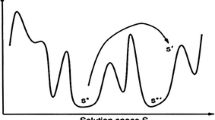Abstract
The planning and configuration of complex flexible production lines—cyclically interlinked systems—cover numerous aspects and various possibilities. It is not possible to determine the applicability and characteristics for each of these variations by applying already existing planning methods. This paper outlines an innovative approach to this problem, which is based on the application of learning algorithms such as artificial neural networks. The iterative design process of a production line is initiated by a customer request. An initial layout is usually planned by an engineer and considered in a forecast system, which classifies the layout as stable or unstable. In case of stable layouts, the performance and cost values are visualized with operating figures. On this basis, the engineer is able to evaluate the layout. If the result is not satisfactory, new production line layouts are generated by modifying the overruled layout and another iteration begins.




Similar content being viewed by others
References
Manns M (2005) Förderengpassprognose verketteter Produktionssysteme mit Nebenflüssen durch neuronale Netze, Dissertation, Universität Hannover, Schriftenreihe IFW, Hannover
Scholz-Reiter B, Müller S, Wiendahl H-P (2000) Throughput time control in production systems supported by neural networks. CIRP Ann 49:331–334
Günthner W (1997) Projektbegleitender Einsatz eines simulationsgestützten Planungswerkzeugs in der Halbleiterproduktion, Vortragsband AIF ‘97, TU München, fml
Bullinger H-J, Rieth D, Euler H-P (1993) Planung entkoppelter Montagesysteme. Teubner, Stuttgart
Kuhn H (1998) Fließproduktionssysteme – Leistungsbewertung, Konfigurations- und Instandhaltungsplanung. Physica-Schriften zur Betriebswirtschaft Nr. 67, Physica, Heidelberg
Nyhuis P, Wiendahl H-P (2003) Logistische Kennlinien. Springer, Berlin
Feldmann K, Stief E (1996) Integrated optimization support tool for simulation. Prod Eng 3(2):79–82
Puppe F (1990) Problemlösungsmethoden in Expertensystemen. Springer, Berlin
Metaxiotis KS, Askounis D, Psarras J (2002) Expert systems in production planning and scheduling: a state-of-the-art survey. J Intell Manuf 13(4):253–260
Tönshoff H-K, Günther G (1997) Fortgeschrittene Methoden der Zustandsüberwachung. Werkstattstechnik 87(7/8):373–376
Feldmann K, Sutanto A (2003) Modular assembly system in a virtual manufacturing environment. In: Proceedings of the 36th CIRP international seminar on Manufacturing Systems, Saarbrücken, pp 137–141
Tönshoff HK, Manns M (2005) Applicability of neuro-fuzzy function approximation in material-flow forecasting. Int J Knowl-Based Intell Eng Syst 9(2):81–92
VDI-Gesellschaft Produktionstechnik (Association of German Engineers) (1990) VDI 2860 - Assembly and handling; handling functions, handling units; terminology, definitions and symbols
DIN Deutsches Institut für Normung e.V. (German Institute for Standardization) (2003) DIN 8593 - Manufacturing processes joining
Zadeh LA (1994) Soft computing and fuzzy logic. IEEE Softw 11(6):48–56
Tönshoff H-K, Czenkusch C, Brinksmeier E, Heinzel C (1997) Modeling of grinding processes with fuzzy and neural nets compared to multiple regression. In: EUFIT 97 5th European Congress on Intelligent Techniques and Soft Computing, Aachen, 3:2064–2068
Levy S, Pollack J (2001) Infinite RAAM: a principled connectionist substrate for cognitive modeling. In: Proceedings of the ICCM-2001 fourth International Conference on Cognitive Modeling
Author information
Authors and Affiliations
Corresponding author
Additional information
The research described in this paper is part of the project “Methode zur Planung komplexer, produktionstechnischer Anlagen mit zyklischer Verkettung” funded by the Deutsche Forschungsgemeinschaft (DFG). It is a is cooperation project between IPH – Institut für Integrierte Produktion Hannover gGmbH and Lehrstuhl für Fertigungsautomatisierung und Produktionssystematik (FAPS) of the Friedrich-Alexander-University Erlangen-Nuremberg.
Rights and permissions
About this article
Cite this article
Tönshoff, H.K., Reinsch, S. & Dreyer, J. Soft-computing algorithms as a tool for the planning of cyclically interlinked production lines. Prod. Eng. Res. Devel. 1, 389–394 (2007). https://doi.org/10.1007/s11740-007-0062-4
Received:
Accepted:
Published:
Issue Date:
DOI: https://doi.org/10.1007/s11740-007-0062-4




